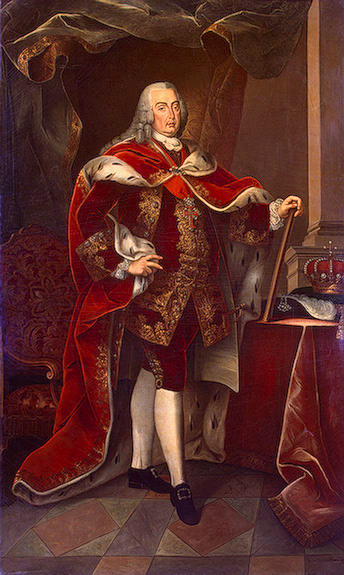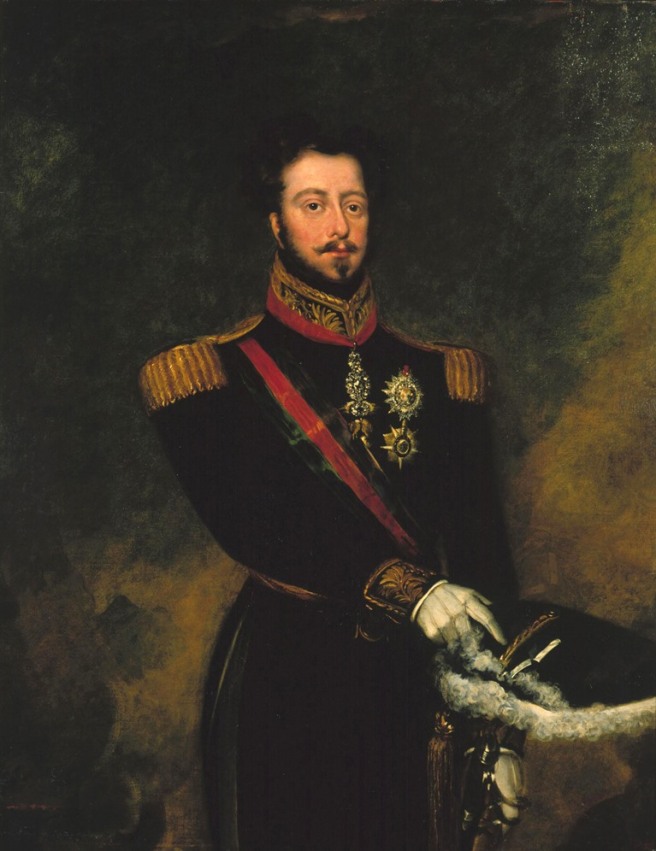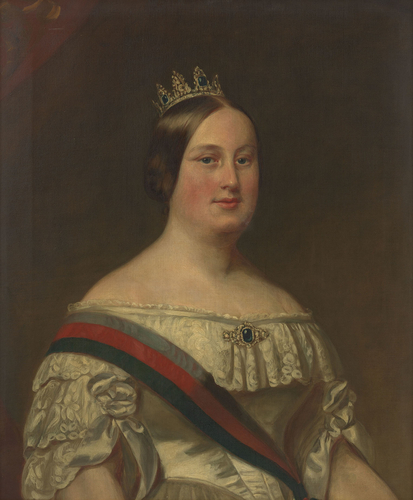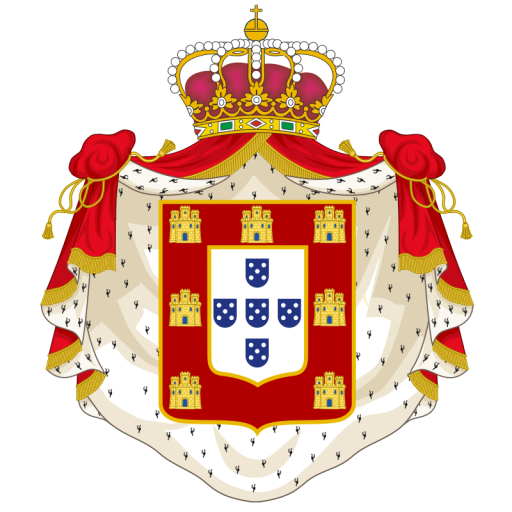
King Dom João IV (1604-1656), The “Restorer”, 8th Duke of Bragança, 21st King of Portugal and the Algarves. Heir to the right to the Crown of Portugal by his Grandmother Dona Catherine, Duchess of Braganza for her marriage to Duke Dom John, and granddaughter of King Dom Manuel I. Married Dona Luísa de Guzmán (1613-1666 ), daughter of the 8th Dukes of Medina Sidonia (Spain). They had one daughter and three sons – Dom Theodosius (1634-1653), 9th Duke of Bragança, Prince of Brazil; Princess Dona Catharine (1638-1705) Portugal, Queen of England, for her marriage, in 1662, to Charles II (1630-1685), King of England; future King Dom Afonso VI (1643-1683), the “Victorious”, 10th Duke of Bragança, etc., married in 1666, with Princess Dona Maria Francisca of Savoy (1646-1683). S.g .; and future King Dom Pedro II, who follows.

King Dom Pedro II (1648-1706), the “Pacific”, 23rd King of Portugal. Regent of the Kingdom (1667-1683), etc., married to Princess Dona Maria Francisca of Savoy (since marriage to Dom Afonso VI was annulled ). Married a second time with Princess Dona Maria Sofia of Neuburg (1666-1699), daughter of Prince Philip William of Neuburg, Elector Palatine of the Rhine, and Princess Isabel Hesse-Darmstad. They had four children – The future King Dom João V, who follows; The Prince Dom Francisco (1691-1742); the Prince Dom António (1696-1757), and Prince Dom Manuel (1697-1766).

S.M.F. El-Rei o Senhor Dom João V (1689-1750) , o “Magnífico”, 24º Rei de Portugal, etc., casado com a Arquiduquesa Dona Maria Ana Josefina Antonieta de Áustria (1683-1754), filha de Leopoldo I, Imperador de Áustria, Rei da Hungria e da Boémia, e da Imperatriz Leonor Madalena de Neuburgo. Tiveram uma filha e quatro filhos – S.A. a Senhora Dona Maria Bárbara (1711-1758), Infanta de Portugal, Rainha de Espanha, casada em 1729, com D. Fernando VI (1713-1759), Rei de Espanha. S.g.; S.M.F. El-Rei o Senhor Dom José I, que segue; S.A. o Senhor Dom Carlos (1716-1736); S.M.F. El-Rei o Senhor Dom Pedro III (1717-1786), Infante de Portugal, etc., casado em 1760, com sua sobrinha a Rainha Senhora D. Maria I (ver adiante), e S.A. o Senhor Dom Alexandre (1723-1728).

King Dom Jose I (1714-1777), the “Reformer”, 25th King of Portugal (1750), etc.. Married in 1732, with Princess Dona Mariana Victoria de Bourbon (1718-1781), daughter of Philip V, King of Spain and Queen Dona Elisabeth Farnese. They had four daughters – Queen Dona Maria I, who follows; Princess. Dona Maria Ana (1736-1813); Princess Dona Dorotéia Francisca (1739-1771); Princess Dona Maria Benedicta (1746-1829), Princess of Brazil, married in 1777, with her nephew Dom José (1761-1788), Prince of Brazil (see below). S.g.

Queen D. Maria I (1734-1816), the “Pious”, 26th Queen of Portugal, etc., married in 1760, with her uncle Dom Pedro (1717-1786), “the Builder”, King Consort (future King D. Pedro III), Grand Cross of the Orders of Christ, St. Benedict of Aviz, and St. James of the Sword; Knight of the Golden Fleece (Spain), etc. They had a daughter and two sons – Prince Dom Dom José (1761-1788), Prince of Brazil, married in 1777, with his aunt Infanta Dona Maria Benedicta de Bragança. S.g .; future King Dom John VI, who follows; and Princess Dona Mariana (1768-1788), Infanta de Portugal, married in 1785, to Dom Gabriel (1752-1788), Prince of Spain, son of D. Charles III, King of Spain.C.g.

King Dom João VI (1767-1826), the “Clement”, 27th King of Portugal, 23rd King of the Algarves, King of the United Kingdom of Portugal, Brazil and Algarves (1815). He was Titular Emperor of Brazil, Prince of Beira and Brazil, 21st Duke of Bragança, 18th Duke of Guimarães, 16th Duke of Barcelos, 20th Marquis of Vila Viçosa, 24th Count of Arraiolos, 22nd Count of Ourém, Count of Barcelos, Faria and Neiva, etc. Married in 1785, with Queen Dona Carlota Joaquina de Borbón (1775-1830), Princess of Spain, daughter of Charles IV, King of Spain, and Queen Maria Luisa de Borbón-Parma. They had six daughters and three sons – Princess Dona Maria Teresa, who married in 1810, with her cousin Prince Don Pedro Carlos de Bourbon and Bragança (1787-1813), with foreign generation, and the 2nd time in 1838, with her uncle and brother-in-law Prince Don Carlos Maria Isidoro de Bourbon, Infante de España. S.g .; Prince Dom António (1795-1801); Princess Dona Maria Isabel (1797-1818), Queen of Spain, by her marriege, in 1816, with her uncle D. Fernando VII, King of Spain. W.g.; Dom Pedro IV (1798 – 1834), King of Portugal, Emperor of Brazil, etc., married in 1817, to Archduchess Dona Maria Leopoldina of Austria (1797-1826), daughter of Francis I, Holy Roman Emperor, and Empress D. Maria Teresa of Naples and Sicily. W.g. in Imperial House of Brazil and in Portugal (See Below – Constitutional Branch – Kings of Portugal – Braganza – Braganza of Saxe-Coburg-Gotha), married 2nd time with Dona Amélie Auguste of Leuchtenberg, W.g. extinct; Princess Dona Maria Francisca (1800-1834), married in 1816, with her uncle, Don Carlos Maria Jose Isidoro de Bourbon (1778-1855), Prince of Spain, Count of Molina, W.g. ; Princess Dona Isabel Maria (1801-1876), Regent of the Kingdom (1826-1828); Prince Dom Miguel (1802-1866), Usurper of the Crown of Portugal (1828-1834), etc., married in 1851, to Princess Dona Adelaide of Lowenstein-Wertheim-Rosenberg (1831-1909). With foreign generatiom (Absolute/Miguelista Branch – Braganza – Herédia de Braganza); Princess Dona Maria d’Assunção (1805-1834); and Princess Dona Ana de Jesus Maria (1806-1857), Infanta de Portugal, etc., married in 1827, with Nuno de Mendóça Rolim de Moura Barreto (1804-1875), 2nd Marquis of Loulé (future 1st Duke of Loulé), etc., with generation. (See below – Constitutional Branch – Dukes of Loulé – Mendóça Rolim de Moura Barreto – Folque de Mendóça – Folque de Braganza and Bourbon de Mendóça).
Branch (Constitutional)
Kings of PORTUGAL
Braganza – Braganza of Saxe-Coburg-Gotha

King Dom Pedro IV, “the Liberator”, eldest son of King Dom João VI and Queen Dona Carlota Joaquina de Bourbon. Upon the return of the Royal Family to Portugal (1821), from Brazil, Dom Pedro, as royal Prince of the United Kingdom of Portugal, Brazil and the Algarves, would remain in Brazil; shortly thereafter, on September,7 1822, he was obliged to give the independence of that Overseas State. From this date he became the 1st Emperor of Brazil with the title of “Perpetual Defender”. In 1831 abdicated in favor of his son Prince Dom Pedro (II). In 1826 decreed the Constitutional Charter of the Portuguese Monarchy, abdicating the throne of Portugal in favor of his daughter Princess Dona Maria (II) da Glória, remaining as Regent in the minority of her, between 1832-34, with the title of Duke of Bragança (22nd) .

Queen Dona Maria II (1819-1853), daughter of King Dom Pedro IV and Archduchess Dona Leopoldina d’Áustria, and as the eldest daughter born before the Independence of Brazil, kept her rights, in full, to the Crown of Portugal, staying from 1826 since the formal abdication of Her Father, as Queen of Portugal. She first married by procurement, in 1826, with her uncle Infante Dom Miguel (marriage dissolved in 1834). She later married Prince Dom Augusto de Leuchtenberg (+1835), and the Cortes waived Article 90 of the Constitutional Charter (so that the Queen could marry a foreigner), and similarly when she married on second time to Prince Fernando de Saxe-Coburg-Gotha, who after the birth of his first son in 1837, was designated King, as Dom Fernando II. Queen Maria II’s descendants will reign in Portugal until the end of the monarchy in 1910.
Queen Dona Maria (II) of Glory Joana Carlota Leopoldina of the Cross Francisca Xavier of Paula Izidora Micaela Gabriela Rafaela Gonzaga of Bragança and Austria (1819-1853), the “Educator”, 30th Queen of Portugal, Princess of Beira, Duchess of Porto, Grand Master of the Orders of Our Lord Jesus Christ, Saint Benedict of Aviz, Saint James of the Sword, Our Lady of Conception of Vila Viçosa, and Santa Izabel – Queen of Portugal; etc.. Married by procurement in 1826, with her uncle, Prince Dom Miguel (this marriage did not take place in person, but was dissolved by the Cardinal Patriarch of Lisbon on 27 November 1834 marriage was not in person, but was dissolved by the Cardinal Patriarch of Lisbon on November, 27 1834). She married for the first time in 1835 with Prince August Charles Eugene Napoleon Beauharnais (1810-1835), Duke of Leuchtenberg, Duke of Santa Cruz. S.g. She married, second time, in 1836 to King jure uxoris Dom Ferdinand (II) August Francis Anthony of Saxe Coburg Gotha (1816-1885), Regent of the Kingdom, Marshal-General of the Portuguese Army, etc., son of Prince Ferdinando George August of Saxe Coburg Gotha, and Princess Maria Antonieta Gabriela Koháry of Csábrág and Szitnya. From this marriage they had seven sons and four daughters – King Dom Pedro V (1837-1861), the “Hopeful”, 31st King of Portugal, Duke of Braganza, Duke of Saxon Coburg Gotha, married in 1858, with Princess Dona Estefânia of Hohenzollern Sigmarigen (1837-1859 ), w.g.; King Dom Luis I, who follows; Princess Dona Maria (n. + 1840), w.g.; Prince Dom João (1842-1861), Duke of Beja, etc. ; Princess Dona Maria Ana (1843-1884), who married in 1859, to Prince Frederick Augustus of Saxe (1832-1904), King of Saxony, with foreign generation; Princess Dona Antonia (1845-1913), who married in 1861, to Prince Leopold of Hohenzollern-Sigmaringem (1835-1905), with foreign generation; S.A. Prince Dom Fernando (1846-1861); Prince Dom Augusto (1847-1889), Duke of Coimbra, etc .; Prince Dom Leopoldo (n. + 1849); Princess Dona Maria (n. + 1851); Prince Dom Eugenio (n. + 1853).
King Dom Luís (I) of Braganza Saxe Coburg Gotha (1838-1889), “the Popular”, 32nd King of Portugal, Duke of Oporto; Duke of Saxe Coburg Gotha, Grand Master of the Orders of Our Lord Jesus Christ, Saint Benedict of Aviz, Saint James of the Sword, Tower and Sword, and Our Lady of Conception of Vila Viçosa, etc .; married in 1862 to Princess Dona Maria Pia of Savoy (1847-1911), daughter of Victor Emanuel II, King of Italy, and Archduchess Maria Adelaide of Austria. They had two children – King Dom Carlos I, who follows; and S.A.R. Prince (Infante) Dom Afonso Braganza of Saxe Coburg Gotha (1865-1920), Royal Prince (February 1, 1908), Duke of Porto, etc .; married in 1917 to Nevada Stoody Hayes (1885-1941). W.g.
King Dom Carlos (I) of Braganza Saxe Coburg Gotha (1863-1908), “the Martyr” or “the Diplomat”, 33rd King of Portugal, Duke of Braganza, Grand Master of all Portuguese Orders, etc .; He married in 1886 to Princess Dona Maria Amelia of Orléans (1865-1951), daughter of the Counts of Paris. They had a daughter and two sons – Dom Luís Filipe (1887-1908), Prince Royal; and King Dom Manuel II, who follows. was the King of Portugal from 1889 until his assassination in 1908. He was the first Portuguese king to die a violent death since Sebastian in 1578.

King Dom Manuel (II) of Braganza Saxe Coburg Gotha (1889-1932), “the Unfortunate” or “the Patriot”, 34th King of Portugal, Duke of Braganza, Duke of Beja, Count of Ourém, Grand Master of all Portuguese Orders, etc. ., married in 1913, to Princess Dona Augusta Victory of Hohenzollern Sigmarigen (1890-1966), daughter of Prince William of Hohenzollern, and Princess Maria Teresa of Bourbon-Sicilies. S.g.
BRANCH – Constitutional
DUKES OF LOULÉ
Braganza – Mendóça Rolim de Moura Barreto – Folque de Mendóça
Folque of Braganza and Bourbon of Mendóça
out the Iberian Peninsula. Descending from D. Iñigo Lopes, 6th Sovereign Lord of Biscay (1025-1076), being entwined by marriage through the centuries with the Royal Houses of Portugal, Castile, León, Navarre and Aragon; and also with the major Families of these Kingdoms, so that you will not find today in the whole peninsula Great House or peer of the Old Nobility, with which it is not related. The Dukes of Loule are the Dynastic line of the Portuguese Royal House, and they have among others, the titles of Duke of Loule (1862), Marquis of Loule (1799), Count of Vale de Reis (1628), Lord of Azambuja (1200), Montargil (13th century), and Póvoa e Meadas (1482); Alcaide-mor (like Mayor) of the Villages of Azambuja (12th Century), Moura (1640), Loulé and Albufeira (17th Century); They are Representative of the house of Duke of Terceira (1832) and of the House of Counts of Rio Grande (1678); The Duke of Loulé are th Head of Name and Arms of Portuguese Mendóças, Barretos, Rolins (Azambujas) and Mouras.
From 1827, with the wedding of Nuno de Mendóça, 2nd Marquis of Loulé (latter 1st Duke of Loulé), heir and successor of this House, with H.R.H. Princess Dona Ana de Jesus Maria de Bragança and Bourbon (1806 – 1857), Infanta of Portugal, youngest daughter of King Dom João VI (1767-1826) and Queen Dona Carlota Joaquina de Borbón (Princess of Spain), the House of the Dukes of Loule as Dynastic Line of the Royal House of Portugal, becomes the first line of succession of the Crown of Portugal, after the Portuguese descendants of Queen Dona Maria II. Thus the members of this House came to be in a position equivalent to that in France (since the XV century) is called Prince du Sang (Prince of the Blood. (in Luiz de Mello Vaz de São Payo, “A Linha de Sucessão”, Revista Raízes & Memórias, nº 9, Associação Portuguesa de Genealogia, Lisboa, 1993, págs. 15 a 21).
This marriage was carried out as prescribed by the old Kingdom laws and the Constitutional Charter for Princess marriages, that is, with prior royal authorization and with a Portuguese. It should be noted that the Marquês de Loulé, besides being Great of the Kingdom, was by the four sides, several times descended from the Royal House of Portugal, and through his grandfather the 3rd Duke of Cadaval, was in the 18th place of the Crown of Portugal Succession Line.
Assim, a Sereníssima Senhora Infanta Dona Ana de Jesus Maria, continuou com todos os direitos que lhe cabiam por nascimento na Sucessão da Coroa Portuguesa, transmitindo à sua descendência os mesmos direitos dinásticos à Coroa de Portugal. A partir de então a Casa dos Duques de Loulé como Ramo Dinástico da Casa Real, ocupa a primeira linha na Sucessão da Coroa. Em 1932, depois da morte d’El-Rei Dom Manuel II, a Herdeira da Casa Loulé, passa a deter a legitimidade de jure na Sucessão da Coroa de Portugal e na Sereníssima Casa de Bragança
Thus, H.R.H Princess Dona Ana de Jesus Maria, maintained all the rights that she had by birth in the Succession of the Portuguese Crown, transmitting to her descendants the same dynastic rights to the Crown of Portugal. From then on, the House of the Dukes of Loule as the Dynastic Branch of the Royal House, occupies the first line in the Crown Succession. In 1932, after the death of King Manuel II, the heiress of Casa Loulé came to have de jure legitimacy in the Succession of the Crown of Portugal and to the House of Braganza (see Casas Reais Europeias – Portugal, Coleção Flash!, SocTip, Lisboa, 2004, pp. 11 e 38).
H.R.H. Princess Dona Ana de Jesus Maria de Braganza and Bourbon (1806-1857), Infanta of Portugal, Marchioness of de Loulé, Countess of Barcelos, Grand Cross of the Order of Our Lady of Vila Viçosa, Lady of the Order of Santa Isabel , and of the Order of the Noble Ladies of Maria Luisa (Spain), etc., Married, in the Chapel of the Royal Palace of Queluz, in December 5, 1827, with Lord Nuno José Severo de Mendóça Rolim de Moura Barreto (1804-1875) , 1st Duke of Loulé (1862), 2nd Marquess of Loulé, 9th Count of Vale de Reis, 24th Lorf of Azambuja, 14th Lord of the Majorat of Quarteira, 12th Lord of Póvoa e Meadas, Representative of the House of Dukes of Terceira (1832) with honors from Royal Relative (1838), Representative of the House of theCounts of Rio Grande, etc .; Gentleman of the King’s House and Crown Equerry of King Dom João VI (and of King Dom Pedro V and Dom Luis I), Hereditary Peer of Realm (1826), President of the Kingdom’s Peer Chamber, President of the Council of Ministers (now Prime Minister) , Member of the Council of State, Division General, Cross of the Orders of the Tower and Sword, Commander of the Order of Christ, Cross of various foreign orders, etc., son of the 1st Marquess of Loulé. They had three daughters and two sons, being the heir and successor:
Dom Pedro (1830-1909), 2nd Duke of Loulé, 3rd Marquis of Loulé, 10th Earl of Valle de Reis, Crown Equerry of the Kings Dom Luis I, Dom Carlos I and Dom Manuel II; Lord Chamberlain of Household of Queen Dona Maria Pia de Savoia, President of the House of Peers, Brigadier General, etc. Married with Lady Constance of Figueiredo Cabral da Câmara, daughter of the 2nds. Counts of Belmonte. The only heiress of the whole House, Was Dona Constança (1889-1965), by Jure Royal Princess, as Heiress of the Constitutional Legitimacy Branch of Sucession to the Royal House of Portugal and to the House of Braganza (from July 2, 1932, on the death of El-King Dom Manuel II); 4th Duchess of Loulé, “de Juro e herdade”, 12th Countess of Vale de Reis, etc. She married to José Pedro de Basto Feyo Folque (1888-1969), Count of Vale de Reis (authorization of El-King Dom Manuel II) , who fought in the monarchical incursions of Galicia (1911/1912) and the Monarchci Restoration of Monsanto (1919), Member of the Political Council of the Majesty, the King Dom Manuel II, etc., son of the Viscounts of Fontaínhas. This marriage had three daughters and two sons, being the heir and successor:
DomAlberto (1923-2003), by Jure Prince of Beira (on the death of King Dom Manuel II on July 2, 1932), Head of the Constitutional Dynastic Branch of the Royal House of Portugal, 5th Duke and 6th Marquess of Loulé, 13th Count of Vale de Reis, Representative of the titles of Dukes of Terceira and the Counts of Rio Grande, etc. Married in 1953 to Lady Maria Augusta Amelia de Moraes Cardoso de Menezes (n. 1932), Grand Lady of the Military Order of Saint Sebastian, said of the Arrow, etc., daughter of Henrique José de Mello Breyner Cardoso de Menezes (Counts of Margaride and Counts of Sobral), and D. Helena de Carvalho Pereira de Moraes (from the Viscounts of Moraes). They had, besides five daughters, three sons, respectively: The Most Serene Dom Pedro (n. 1958), Head of the Constitutional Dynastic Branch of the Royal House of Portugal (as by the Law of the Succession to the Crown of the Portuguese Monarchy and as by other legislation in force until October 5, 1910), 6th Duke of Loulé, etc., married in 1997 with D. Margarida Vaz Pinto (divorced). W.g .; The Most Serene Sir Dom Henrique (n. 1964), who married in 1994, with D. Teresa Cardoso de Menezes (n. 1966), W.g .; The Most Serene Dom Filipe (n. 1967), Count of Rio Grande, etc.


